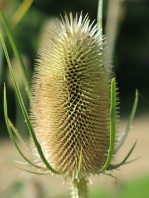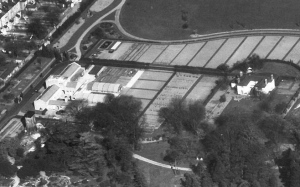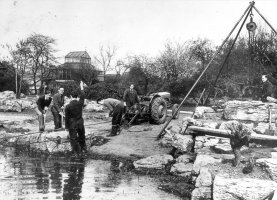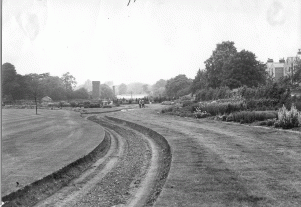● Work begins on Eastern Garden ● Key Events ● Allotment Clearing ● New Optimism in Britain ● The Chronological Bed ● Laying New Paths ● Tertiary Trees ● British Wild Flowers ● Limestone Rock Garden ● Key People ●
 The Western Garden and the New Development Plan This watercolour map of the historic Cambridge University Botanic Gardens was created in 1952, by artist, Roger De Simone. It pre-dates the development of the eastern Garden, however there are clues that changes were taking place; the map mentions the allotments that were being cleared during the early 1950s. Calligraphy down the left side reads: ‘Allotments open to the new development plan 1953’. The text below mentions: ‘….The Allotments occupy about 13 acres on the east side of the garden…’.
The Western Garden and the New Development Plan This watercolour map of the historic Cambridge University Botanic Gardens was created in 1952, by artist, Roger De Simone. It pre-dates the development of the eastern Garden, however there are clues that changes were taking place; the map mentions the allotments that were being cleared during the early 1950s. Calligraphy down the left side reads: ‘Allotments open to the new development plan 1953’. The text below mentions: ‘….The Allotments occupy about 13 acres on the east side of the garden…’.
Seeds of Change The second-half of the twentieth-century was a period of great change for the Cambridge University Botanic Garden. In fact, the seeds of the New Development Plan of the Eastern area of the Garden in the 1950s – also known as the New Garden or the Garden Extension – were sown much earlier, during the 1920s and 1930s.
From left: Reginald Cory, Humphrey Gilbert-Carter, John Gilmour, three key figures in the development of the new eastern extension section of the Botanic Garden.
Humphrey Gilbert-Carter, the first scientific Director of the Garden (1921 – 1950) cultivated a long-standing friendship with Reginald Cory, keen botanist and a wealthy alumnus of Trinity College. Cory, described as ‘one of the best friends of the University Botanic Garden’ left a generous bequest to the Botanic Garden when he died in 1934. Cory had already donated money for the design and construction of Cory Lodge (1924-1925), the Director’s residence in the 1920s.
Enabling Change The legal complexities of the Cory Fund were not unravelled until after WWII; the war interrupted the work of the Botanic Garden during the late 1930s – 1940s. By the time the bequest had come on stream, Director, Humphrey Gilbert-Carter was about to retire, after 29 years leading the Garden. The formidable but exciting task of reclaiming the eastern 20-acres of allotments fell to Gilbert-Carter’s successor, Director, John Gilmour (1951 – 1973) and his Garden Superintendent, Bob Younger (1947 – 1974).
Working together John Gilmour and Bob Younger forged ‘a wonderful partnership’. The Cory Fund allowed Gilmour and Younger to introduce new landscapings and to experiment with new ideas in the Garden. First, they set to work to clear the allotments, a task that was to take several years and was carried out in two stages. By 1955, the first section of the new Garden was finally ready for planting. In 1954, they began work on another major long-term landscaping feature – The Limestone Rock Garden.
Key Events of the 1950s
1950 Humphrey Gilbert Carter, Director (1921 – 1950) retires after 29 years
1951 John Gilmour (1951 -1973) appointed as Director
1951 Festival of Britain and Exhibition of Science, The Science Museum, London
1952 Works begins on clearing the allotments for the new Garden eastern extension
1953 Coronation of Queen Elizabeth II
1953 First Winter Garden laid out in 1953 – 1954
1954 Construction of the Limestone Rock Garden took four years to complete
1954 JSL Gilmour and SM Walters publish Wild Flowers: Botanising Britain
1955 ‘New area’ allotment clearing complete ready for levelling and grass sowing
1955 GS Thomas publishes The Old Shrub Roses
1955 Sir Winston Churchill retires as Prime Minister, Sir Anthony Eden takes over
1956 Sheep grazed in the eastern section prior to planting in autumn 1956
1956 CAMBIENT Nature Conservation Council offices at Brookside
1957 Cory Laboratories and experimental glasshouses constructed
1957 A half-mile of paths constructed in the new eastern extension area
1957 Sir Anthony Eden resigns. Harold Macmillan becomes Prime Minister
1958 The Chronological Border planting completed
1958 Nature in Cambridgeshire journal established
Allotment Clearing Work on clearing the 20-acres of allotments was a formidable, if exciting, task for the Garden team; one that took several years to complete. Horticultural staff employed a stump-drawer, a bulldozer and sheer hard graft to clear the site in two sections. By 1955, the southern area had been levelled and sown with grass. Over the summer of 1956, sheep were put to graze, prior to planting. The northern section was completed by late 1956 and planting of the whole area began in earnest in the autumn/winter of 1956-57. Preparing the ground created mixed emotions for some. T D Harvey recalls his time as a student trainee in the 1950s: ‘For the first six months we toiled on the clearance of the old allotments in preparation of the enlargement of the Garden. It was exciting in some respects, to feel that one was in at the beginning of this new and important development, but there was also a tinge of sadness at the destruction of the many individualistic gardens which had brought great pleasure to their owners.’
 ‘Cambridge University Can Indeed Be Proud of Its Botanic Garden’ … ‘The new portions of Cambridge Gardens include a large Winter Garden [1953 – 54] but even here the boundary hedges are part of an experiment to ascertain the relative value of nine different evergreen shrubs…. A space has also been allotted for research in other branches of botany, including plant physiology under nature conditions, etc, and this will be situated in close connection with the new laboratories.’ Sport & Country Magazine, 1st May 1957.
‘Cambridge University Can Indeed Be Proud of Its Botanic Garden’ … ‘The new portions of Cambridge Gardens include a large Winter Garden [1953 – 54] but even here the boundary hedges are part of an experiment to ascertain the relative value of nine different evergreen shrubs…. A space has also been allotted for research in other branches of botany, including plant physiology under nature conditions, etc, and this will be situated in close connection with the new laboratories.’ Sport & Country Magazine, 1st May 1957.
‘The Garden is not only a teaching centre, an amenity for casual visitors and a living catalogue of plants for amateur gardeners and plant-lovers, but it also plays a part in the practical distribution of new plant species.’ Sport and Country Magazine, 1st May 1957
 New Optimism in Britain The timing of the reclamation of the allotments for the Botanic Garden was fortuitous. Allotments were out and flowers were in. Following nearly a decade of traumas and austerities of World War II, a spirit of optimism, excitement and regeneration returned to Britain during the early Fifties. The young Queen Elizabeth II ascended the British throne in 1953. Popular music was literally being shaken up by rock and roll from America, television sets began entering British living rooms and on the Continent, Christian Dior’s ‘New Look’ introduced soft, flattering, colourful fashions for women. Colour, beautiful shapes and fragrance were also returning to the gardens of Britain. Across the country, utilitarian ‘Dig for Victory’ vegetable plots and allotments were happily being dug over and in their place, colourful and non-essential flowers were being planted. Rationing may not have ended until 1954, however British gardeners were keen to bring back blooms. In their book, Digging for Victory, Twigs Way and Mike Brown recall how the famed rose grower, Harry Wheatcroft, introduced a beautiful yellow rose, called ‘Peace’ into Britain, from France, in 1948. It became an instant best seller and thousands of specimens were planted across the country.
New Optimism in Britain The timing of the reclamation of the allotments for the Botanic Garden was fortuitous. Allotments were out and flowers were in. Following nearly a decade of traumas and austerities of World War II, a spirit of optimism, excitement and regeneration returned to Britain during the early Fifties. The young Queen Elizabeth II ascended the British throne in 1953. Popular music was literally being shaken up by rock and roll from America, television sets began entering British living rooms and on the Continent, Christian Dior’s ‘New Look’ introduced soft, flattering, colourful fashions for women. Colour, beautiful shapes and fragrance were also returning to the gardens of Britain. Across the country, utilitarian ‘Dig for Victory’ vegetable plots and allotments were happily being dug over and in their place, colourful and non-essential flowers were being planted. Rationing may not have ended until 1954, however British gardeners were keen to bring back blooms. In their book, Digging for Victory, Twigs Way and Mike Brown recall how the famed rose grower, Harry Wheatcroft, introduced a beautiful yellow rose, called ‘Peace’ into Britain, from France, in 1948. It became an instant best seller and thousands of specimens were planted across the country.
‘You’ve never had it so good.’ In 1955, the elderly Prime Minister, Sir Winston Churchill (Cons) retired and was succeeded by Anthony Eden (1955 – 1957) and two year’s later by Harold ‘Supermac’ Macmillan, (1957 – 1963). Macmillan won the 1959 election with the slogan, which has became popularized as: ‘You’ve never had it so good.’
Laying the New Paths An unusual method of path-laying was employed in the new Garden. ‘Mr Gilmour and Mr Younger have taught me many things’, writes Jack Stevens in their memorial volume, ‘….for instance, the necessity of correctly worded notices [labels] throughout the Garden and the unorthodox method of path layout used in the new area, which consisted of driving a lorry around and using the wheel tracks as markers.’
 British Wild Flowers John Gilmour was passionate about British wild flowers and was a pioneer conservationist. He authored several books on British wild flowers. In 1947, he wrote Wild Flowers of the Chalk. During the 1950s, he co-authored two books with Max Walters (Director 1973 – 1984). The first volume, entitled Wild Flowers: Botanising Britain, was published by Collins in 1954. Their second collaboration New Naturalist No. 5: Wild Flowers, also by Collins, was published the following year.
British Wild Flowers John Gilmour was passionate about British wild flowers and was a pioneer conservationist. He authored several books on British wild flowers. In 1947, he wrote Wild Flowers of the Chalk. During the 1950s, he co-authored two books with Max Walters (Director 1973 – 1984). The first volume, entitled Wild Flowers: Botanising Britain, was published by Collins in 1954. Their second collaboration New Naturalist No. 5: Wild Flowers, also by Collins, was published the following year.
Limestone Rock Garden developed out of John Gilmour’s personal passion for wild flowers and his idea that the existing rockery next to the Glasshouse range was too small.
The construction of a new Limestone Rock Garden by the lake – mostly from Westmoreland limestone and Sussex sandstone – was one of Gilmour and Younger’s most ambitious projects. It required the manual physical hauling of large blocks of stone – up to three tonnes in weight – to create the rocky base. It is estimated that 900 tonnes of north Lancashire limestone pavement were used in its construction. The crumbly Sussex sandstone would be replaced in 1964 by Yorkshire millstone-grit. Stone blocks were manoeuvered into place with a tripod lifting system. A doline, or sunken section, was dug by hand to create nooks for shade-loving plants. This considerable feat requiring digging into the chalk below the soil. The doline was lined with limestone. Today, a wooden bench allows visitors to contemplate this quiet corner of the rock garden. Changing attitudes to the use of limestone pavement means that the use of this native stone would not be permitted. Today limestone pavement is top of the UK’s list for conservation of threatened habitats.
 The Cory Laboratories and Experimental Glasshouses
The Cory Laboratories and Experimental Glasshouses
The Cory Fund also enabled the construction of the Cory Laboratories in 1957. The Cory Labs were the centre of the Botanic Gardens scientific research and experimentation during the late 20th-century. The Labs were located in the private research section of the Garden. The laboratory buildings and experimental glasshouses can be seen to the left of this 1960s aerial photograph. Despite several refurbishments – the latest in 1997 – by the early 21st century, the Cory Labs were outdated and were demolished to make way for the building of The Sainsbury Laboratory (SLCU) in 2008.
The Chronological Border Another of John Gilmour’s personal projects was ‘a very interesting and novel exhibit’, the Chronological Border. The original herbaceous display was completed in 1958. This fascinating planting allows visitors to walk along a timeline of herbaceous and shrub plants – in 20 year periods – introduced into the British Isles over the past 500 years. The Chronological Bed reflects geopolitical and economic interests from the invasion of the Romans to the expansion of the British Empire. The colourful displays of plants in the Chronological Border echo the changing imperatives and preoccupations of plant collectors and travellers through the centuries.
Plants were imported for a variety of reasons. Some were desired for their economic value, for example, tobacco Nicotiana tabacium introduced in the 16th century from Central America. Others were valued for their medicinal and culinary properties, rosemary Rosmarinus officinalis from the Mediterranean and some for the enjoyment of their exotic provenance and interesting characteristics, eg Physalis alkekengi Chinese lantern, introduced from the Far East and Cortarderia jubata or South American pampas grass.
 Tertiary Trees The term ‘Tertiary Trees’ refers to a group of deciduous trees, such as the Manna Ash, Fraxinus ornus, and the Hop Hornbeam (right) Ostrya carpinifolia (Betulaceae, Birch Family) that thrived in Britain during the Tertiary period (approximately 65.5 – 2.6 million years ago). These ancient tree species were planted in the Botanic Garden between 1951- 1973. Director, John Gilmour was concerned about the disappearance of these – and other deciduous trees – that became extinct in Britain during the period of ice-ages.
Tertiary Trees The term ‘Tertiary Trees’ refers to a group of deciduous trees, such as the Manna Ash, Fraxinus ornus, and the Hop Hornbeam (right) Ostrya carpinifolia (Betulaceae, Birch Family) that thrived in Britain during the Tertiary period (approximately 65.5 – 2.6 million years ago). These ancient tree species were planted in the Botanic Garden between 1951- 1973. Director, John Gilmour was concerned about the disappearance of these – and other deciduous trees – that became extinct in Britain during the period of ice-ages.

Key People
Humphrey Gilbert-Carter (right), the first academic Director of the Cambridge University Botanic Garden (1921 – 1950) and Curator of the Cambridge University Herbarium, retired in 1950. Gilbert-Carter had laid the ground-work for his successor, John Gilmour, begin to doubling the size of the Botanic Garden thanks to the Cory Fund bequest. Gilbert-Carter was a charismatic botanist who had worked for the Botanical Survey of India before taking up the directorship of the Garden. It was his friendship with Reginald Cory, the Garden’s generous benefactor, that led to the transformation of the eastern section.
John Gilmour took over the Directorship of the Garden in 1951. Gilmour and his horticultural team began work on shaping the newly re-acquired eastern half of the Garden towards Hills Road.
Garden Voices from the 1950s Listen to Norman Villis talking about the Cory funding. Peter Sell recalls Humphrey Gilbert-Carter (1921-1950). Norman Villis remembers his horticultural training in the 1950s and Bob Younger’s unconventional method of path laying.
View the post-WWII Garden from the Air.
1951 Exhibition of Science In conjunction with the 1951 Festival of Britain, the 1951 Exhibition of Science was held at the Science Museum, London.
Follow the story of how the Botanic Garden has grown and evolved: A Garden through time, 1960s Ecology by Design, 1970s Conservation, Conservation, Conservation, 1980s Biodiversity,1990s Sustainability for Survival, 2000s Engaging with Plant Sciences, The Future is Now
















